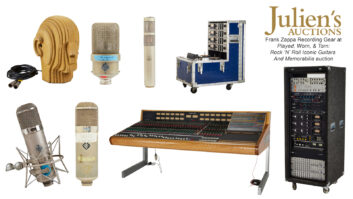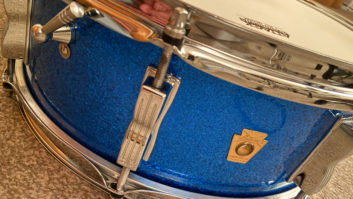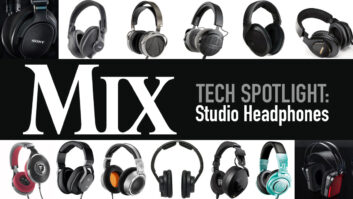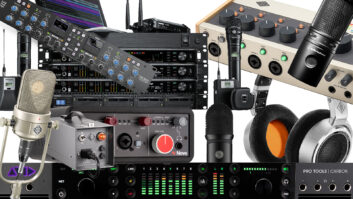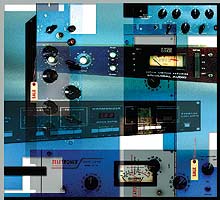
I saw a bumper sticker bearing the word “Lottery,” followed by the phrase: “A tax on people who are bad at math.” Certainly, most of us know we have little chance of winning the lottery, but hope springs eternal, and along the same lines many of us ignore the “math” and look for the potential good in other areas — people, projects, gear. So I’d like to address the considerations (psychological, emotional and technical) of shopping for equipment and offer a few simple guidelines. Your goal? To minimize buyer’s remorse and a technician’s scorn, as in, “You paid how much?”
The motivation to buy any sonic tool is fueled by passion, the same muse that inspires the art we make. Whenever possible, such emotions should be tempered in lieu of clarity of mind so that technical and business considerations can enter the equation.
Unfortunately, technicians are notoriously unreliable at giving investment advice. Classic guitars, mics and signal processors — often valued at irrational exuberance levels — present a challenge to a tech’s rational logic. Yet a good tech can see both hidden beauty and ugliness and can turn broken, undervalued “junk” into something useful while knowing the pitfalls — i.e., where the bodies are buried.
The Coin Toss
When shopping for used gear, “condition” is a keyword, the subset of which can be “functional,” “questionable” or “broken.” If long-term functionality and reliability are important, then look for seller confidence in the form of a trial period, a money-back guarantee within that time and a warranty. When you’ve got all three, pay the asking price and be happy. Even when you’ve done everything right, owning vintage gear means being prepared for something to go wrong. You’ll need both cash and a short list of emergency-care techs close at hand.
When a seller says, “Lights up, but I have no way of testing it,” that generally means the item is a fixer-upper, especially when the price is very low. Similarly, a 30-something microphone might power up just fine, but can it do that multiple times — like in a moment of need?
We should not be overly impressed by a classic until it’s evaluated; nor should we undervalue an impressive piece of technology, even if the seller can’t give it away. For the latter, I’m thinking of a low-mileage $3,000 digital tape machine that can be had for $150. It’s worth much more than the selling price, but needs at least $300 of TLC. Yet the unit is still a steal at $500 with shipping.
Testing, 1-2-3
If you’re considering a spendy classic, try to have a specialist confirm both its condition and authenticity. This is especially true if the seller believes the item to be “original,” which, in many cases, such as a U47 mic, is unlikely. That’s not to say that the variations are sonically flawed — many are great-sounding mics — but there are quite a few U47s out there with a Neumann badge and serial number, with little else inside the mic that was made by Neumann.
Whenever time and money allow, compare two versions of the item in question. For something 30-plus years old, the window of “normal” can be very wide. Take advantage of rental companies and any dealers with a generous return policy so that you can simultaneously rent an original and audition the new/retro/reissue/restored version that you are considering purchasing. Often, the new item sounds better than the classic. And be aware that “identical” products (such as several 1176 limiters) can sound quite different due to production variations, internal adjustments (distortion) and component aging. If possible, compare items within a similar serial number range.
Side-by-side comparisons are educational even when you’re not considering a purchase. If the item in question is a piece of outboard — EQ or dynamics, for example — send the same signal to as many devices (via “Y” cable, console routing or patchbay mults) and monitor via mixer or workstation. Tweak the magic box until you’re satisfied, then mix in an equal amount of the competitor but reverse the polarity and tweak until the signals cancel as best as possible. The residual artifacts will be both musical (harmonically related distortion) and nonmusical (hum, hiss and nastier distortion).
The next step is to capture and loop a section, and alternately solo each track, and then see if you can identify which device the artifacts belong to. Keep in mind that distortion is typically below 1 percent, so it won’t be obvious. Assuming you get a decent subtractive null, the device that sounds “louder,” richer and, yes, warmer most likely has the higher distortion. This matter of personal taste also extends itself to hardware-vs.-software comparisons. Lack of null cancellation typically implies latency. After capturing raw and processed analog tracks, zoom in to determine the latent channel and then insert a sample delay on the opposite channel to compensate.
Hiss and hum levels are typically higher for vintage gear due to the tolerances of that era — analog tape was always noisier; turntable rumble overshadowed hum on the original recording. Selecting low-noise components (tubes, transistors, FETs and resistors) can lower hiss. Bringing the power supply into the modern era can reduce hum. This can be as simple as replacing/upgrading parts, or as complex as adding regulation and improving ground distribution. And here, “original” doesn’t necessarily equal “better.”
Kicking the tires on a car may not show much, but looking under the hood can be revealing. Excessive heat turns circuit boards brown, makes resistors hard to read and reduces capacitor life. Shorted capacitors can cause power transformers to overheat and fail. Speaking of visual inspections, Fletcher from Mercenary Audio offers this tip: Silkscreen wear-pattern around major controls (like control room level) is a sign of heavy use. Pop the hood and look for replaced parts (like capacitors) and other signs of good routine maintenance.
The Final Tweak
We all want a low-mileage piece of gear owned by the little old lady from Pasadena, but these items are rare. Vintage audio gear was typically powered 24/7, often in a smoky environment, which means it will require a healthy dose of TLC.
I’m always amazed by the amount of vintage recording equipment that has narrowly avoided the dumpster. Back in the mid-’80s, when ABC was upgrading its video facilities, I remember a station wagon pulling up to Ramco Electronic Surplus on Canal Street in New York City. It was filled with Pultec equalizers that were selling for $95 each!
Back then, I didn’t have the money. But even today, there are still good deals to be had for recent and vintage gear — if you’re willing to look around and apply some care and common sense.
Visit Eddie Ciletti on the Web atwww.tanglble-technology.com.
AUDIO SCIENCE
WHAT TECHNICIANS LOOK FOR
Capacitors are in every piece of audio gear, and of all of the passive electronic components, they have the shortest life expectancy. Bad caps in a power supply cause hum. In the audio path, open caps filter low frequencies, and shorted caps pass DC instead of blocking it. (Mis-biased tubes, transistors and op amps will distort and run hot, causing premature failure.)
In vintage gear, switch contacts were larger, had greater spring tension, a thicker precious-metal plating, and with daily use were inherently self-cleaning. The design was either “open” or easily disassembled for cleaning. From the ’70s onward, switches and pots got smaller, and had less contact pressure, and thinner plating and conductive coating. Modern parts are typically sealed, making them nearly impossible to expose, and they are often custom-made so generic parts won’t fit.
— Eddie Ciletti



